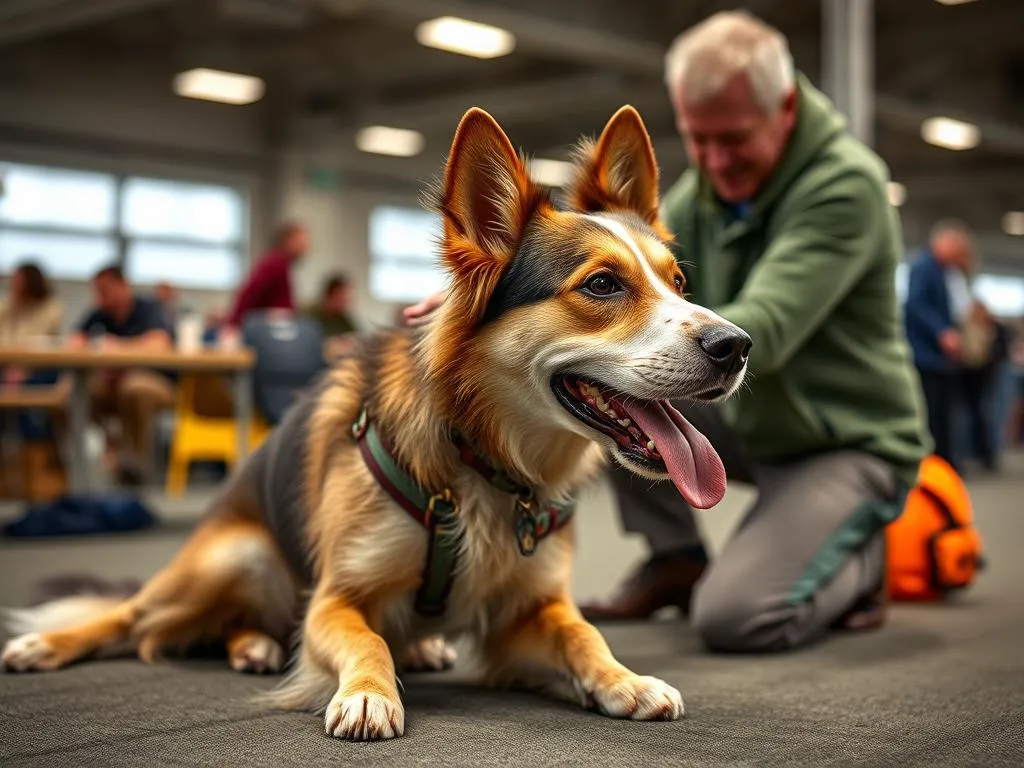
Introduction
Training a show dog requires dedication, patience, and a solid understanding of what makes a dog stand out in the competitive world of dog shows. A show dog is specifically bred and trained for competition in dog shows, where they are judged based on their breed standards, appearance, and performance. Proper training is essential for success in these events, as it helps to groom the dog not just physically, but behaviorally as well, ensuring they can present themselves confidently in the ring.
The goals of this guide are to provide a comprehensive approach to training a show dog, highlighting key techniques and best practices that can help both novice and seasoned handlers achieve success in the competitive world of dog shows.
Understanding Show Dog Standards
Breed-Specific Standards
Every breed has specific characteristics and standards that are used in competitions. Understanding these breed-specific standards is crucial for anyone serious about training a show dog. Each breed has traits that judges look for, such as size, coat type, and overall physical attributes.
Familiarizing yourself with these standards not only helps in training but also ensures that you can evaluate your dog’s progress and readiness for shows. For instance, a Great Dane will have vastly different requirements compared to a Dachshund. Knowledge of these differences plays a vital role in how you approach training.
The Role of Conformation
Conformation is a critical aspect of dog show competitions. This term refers to the physical structure of the dog and how well it adheres to the breed standards. Judges evaluate dogs based on their conformation, which includes posture, movement, and overall appearance.
Training significantly impacts a dog’s physical presentation in the show ring. Well-trained dogs exhibit better posture, movement, and responsiveness to their handlers, all of which can influence judging outcomes. Thus, understanding conformation and its importance is a foundational element in training a show dog.
Preparing for Training
Choosing the Right Dog
Selecting the right dog for show training is a crucial step that can affect your success in competitions. Not all dogs have the temperament or physical attributes required for show performance. When choosing a show dog, consider the following factors:
- Temperament: Look for a dog that is friendly, confident, and eager to learn. A calm demeanor is essential as it translates well in the show ring.
- Physical Attributes: Ensure that the dog meets the breed standards in terms of size, coat, and structure.
Choosing a dog with a strong pedigree can also give you an advantage, as these dogs are often bred for both show quality and temperament.
Setting Up a Training Environment
Creating an ideal training environment is essential for effective learning. Here are some considerations:
- Training Locations: Indoor spaces are great for control and focus, while outdoor areas can help with socialization and acclimatization to different environments.
- Necessary Equipment: Invest in quality training equipment, such as leashes, collars, and grooming tools. A clicker can also be useful for positive reinforcement training.
Setting up a distraction-free zone during initial training sessions can help your dog concentrate better.
Basic Training Fundamentals
Socialization
Early socialization is vital for show dogs. A well-socialized dog is more comfortable in various environments and with different people and animals. Here are techniques for effective socialization:
- Exposure: Introduce your dog to various settings, sounds, and other dogs. Start with calm environments and gradually increase the level of stimulation.
- Positive Experiences: Reward your dog with treats and praise during socialization to create positive associations.
Basic Commands
Mastering basic commands is essential for any dog, especially show dogs. The following commands are foundational:
- Sit: A basic command that helps establish control.
- Stay: Teaches the dog to remain in a position until released.
- Come: Important for recall and maintaining control in public settings.
- Heel: A crucial command for movement in the show ring.
Using positive reinforcement and clicker training can significantly enhance your dog’s learning experience. Reward your dog immediately after they perform the desired behavior to reinforce the command.
Advanced Training Techniques
Heeling and Movement
Proper heeling is critical in the show ring. A well-trained dog should walk beside its handler with a loose leash, showcasing confidence and control. Here’s how to teach heeling:
- Start Slow: Begin in a quiet space with minimal distractions.
- Use Treats: Encourage your dog to walk beside you using treats as a lure.
- Practice: Gradually introduce distractions and practice in different environments.
Stacking and Presentation
Stacking is the technique of positioning a dog to showcase its conformation to judges. Here are some tips:
- Practice Stacking: Train your dog to stand still with its legs positioned appropriately. Use treats to guide them into the correct stance.
- Handler Positioning: Stand tall and confident, presenting your dog effectively to the judge. Your body language plays a crucial role in how your dog is perceived.
Gaiting
Gaiting is the movement of the dog as it walks or runs in the ring. Here’s how to train your dog for effective gaiting:
- Focus on Rhythm: Teach your dog to move smoothly and rhythmically. Use a consistent pace and encourage your dog to maintain focus on you.
- Practice in the Ring: Whenever possible, practice gaiting in environments similar to those of competitions to build familiarity.
Grooming for Show Dogs
Grooming Basics
Grooming is a fundamental aspect of show preparation. Regular grooming not only keeps your dog looking its best but also helps in bonding. Here are essential grooming tools you should have:
- Brushes
- Combs
- Nail clippers
- Bathing supplies
Breed-Specific Grooming Techniques
Different breeds have unique grooming requirements. For example, long-haired breeds may need regular brushing to prevent mats, while short-haired breeds may require less maintenance but still benefit from regular baths. Timing is also essential; grooming should be performed regularly, with extra attention given just before a show to ensure the dog is clean and presentable.
Show Day Preparation
Final Checklist
Preparing for the big day involves careful planning. Here’s a checklist of items to bring to the show:
- Leash and collar
- Grooming supplies
- Food and water
- Treats for rewards
Conduct last-minute training sessions to warm up your dog. This can help reduce anxiety and enhance performance.
Calming Techniques
Keeping your dog calm and focused on show day is crucial. Here are some strategies:
- Routine: Maintain a consistent routine leading up to the show. Familiarity can help reduce anxiety.
- Breathing Exercises: Teach your dog to take deep, calming breaths. This can be effective in managing stress.
Common Challenges and Solutions
Behavioral Issues
Behavioral problems can arise during training. Common issues include:
- Distractions: Dogs may become distracted during training, losing focus on commands. Address this by gradually increasing distractions in a controlled manner.
- Barking: Excessive barking can be a problem in shows. Train your dog to recognize when it’s appropriate to bark and when to remain quiet.
Performance Anxiety
Performance anxiety is a common challenge in show dogs. Signs may include excessive panting, pacing, or refusal to enter the ring. Here are tips for managing anxiety:
- Desensitization: Gradually expose your dog to show environments to build confidence.
- Calm Environment: Ensure your dog is in a calm space before entering the ring.
Resources for Dog Trainers
Recommended Books and Websites
While training, it can be helpful to consult various resources. Look for reputable books and websites that provide insights into dog training techniques and breed standards.
Professional Training Classes
Enrolling in a specialized dog training class can provide significant benefits. Professional trainers offer structured programs tailored to show dogs, helping refine your dog’s skills. When choosing a trainer, consider their experience in show dog training and their approach to positive reinforcement.
Conclusion
Training a show dog is a rewarding journey that requires commitment and knowledge. Understanding the importance of breed standards, socialization, and grooming can significantly impact your success in the show ring. As you embark on this adventure, remember that every training session is an opportunity for bonding and growth.
With dedication and patience, you can enjoy the process of training a show dog while preparing for the exciting challenges ahead.
FAQs
What age should I start training my show dog?
Starting training as early as possible is beneficial. Puppies can begin basic socialization and commands around 8 weeks old.
How long does it take to train a dog for shows?
Training duration varies by dog and handler experience. On average, it may take several months to a couple of years to prepare a dog for competition.
Can any breed become a show dog?
While any dog can compete in some form of dog shows, only purebred dogs recognized by organizations like the AKC can compete for conformation titles.









